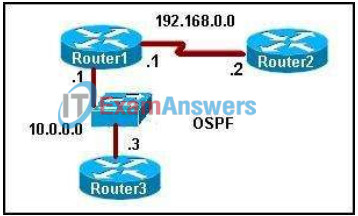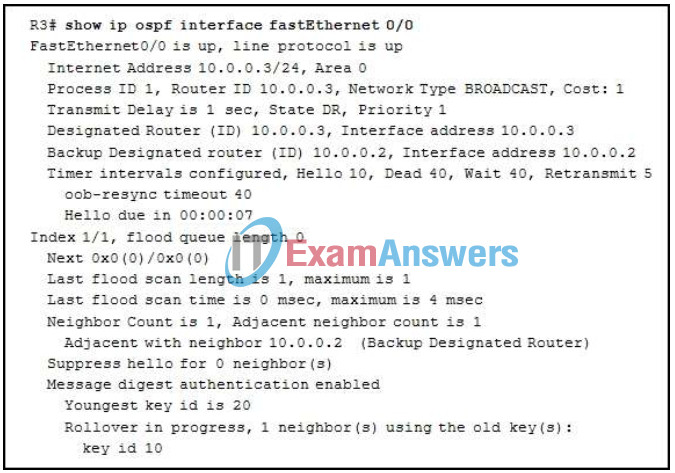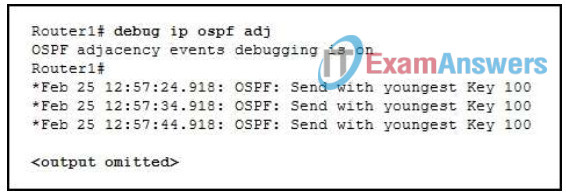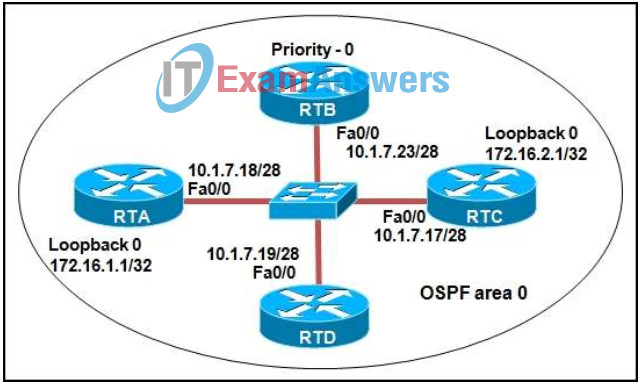Assessment – ROUTE Chapter 3 – CCNP ROUTE (Version 6.0) Exam Answers
1. Which OSPF network type requires the election of a DR/BDR?
- broadcast
- point-to-point
- point-to-multipoint
- point-to-multipoint nonbroadcast
2. In an OSPF hub-and-spoke topology, what needs to be done to ensure that the spoke routers would never be selected as DR and BDR?
- Because nonbroadcast networks do not elect a DR/BDR, nothing needs to be done.
- All routers must be configured with an OSPF interface priority of 0 (ip ospf priority) to disable the DR/BDR election process.
- All spoke routers need to be configured with an OSPF interface priority of 0 (ip ospf priority) so that they will not become the DR/BDR.
- One of the spoke routers will need to be configured as the DR by setting the OSPF interface priority higher than 1 (ip ospf priority).
3. A network administrator is implementing OSPF in a portion of the network and must ensure that only specific routes are advertised via OSPF. Which network statement would configure the OSPF process for networks 192.168.4.0, 192.168.5.0, 192.168.6.0, and 192.168.7.0, now located in the backbone area, and inject them into the OSPF domain?
- r1(config-router)# network 192.168.0.0 0.0.0.255 area 1
- r1(config-router)# network 192.168.4.0 0.0.3.255 area 1
- r1(config-router)# network 192.168.4.0 0.0.15.255 area 1
- r1(config-router)# network 192.168.0.0 0.0.3.255 area 0
- r1(config-router)# network 192.168.4.0 0.0.3.255 area 0
- r1(config-router)# network 192.168.4.0 0.0.255.255 area 0
4. What two advantages does authentication provide that should be considered when planning an OSPF implementation? (Choose two.)
- It reduces OSPF information exchange overhead.
- It encrypts routing tables to prevent unauthorized viewing.
- It prevents routing information from being falsified in transit.
- It ensures that routing information comes from a valid source router.
- It ensures that OSPF routing information takes priority over RIP or EIGRP updates.
5. When will a router in an OSPF nonbackbone area receive a default route from the ABR or ASBR? (Choose three.)
- when the area is a normal area
- when the area is a NSSA stub area
- when the area is a totally stubby area
- when the area is a NSSA totally stubby area
- when the area is connected to the backbone area using a virtual link
- when the area is a normal area and the ASBR has been configured with the default-information originate
- always command
6. What are two reasons for creating an OSPF network with multiple areas? (Choose two.)
- to protect against the fact that not all routers support the OSPF backbone area
- to ensure that an area is used to connect the network to the Internet
- to reduce SPF calculations
- to reduce use of memory and processor resources
- to simplify configuration
7. What does OSPF use to calculate the cost to a destination network?
- bandwidth
- bandwidth and hop count
- bandwidth and reliability
- bandwidth, load, and reliability
8. Which three items must match between OSPF neighbors in order to form an adjacency? (Choose three.)
- hello/dead interval
- area ID
- priority ID
- authentication type
- adjacency type
- router process ID
9. Refer to the exhibit. When OSPF is operational and converged, what neighbor relationship is developed between Router1 and Router2?

- A FULL adjacency is formed.
- A 2WAY adjacency is formed.
- Router2 will become the DR and Router1 will become the BDR.
- Both routers will become DROTHERS.
10. A fully converged five router OSPF network has been running successfully for several weeks. All configurations have been saved and no static routes are used. If one router loses power and reboots, what information will be in its routing table after the configuration file is loaded but before OSPF has converged?
- All routes for the entire network will be present.
- Directly connected networks that are operational will be in the routing table.
- Because the SPF algorithm has not completed all calculations, no routes will be in the table.
- A summary route for all previously learned routes will automatically appear in the routing table until all LSPs have been received by the router.
11. What are two effects of using multiple OSPF areas that reduce bandwidth and router overhead? (Choose two.)
- prevention of a flood of queries
- reduction in the size of the LSDB
- reduction in the size of the neighbor table
- limits on the propagation of type 1 and 2 LSAs
- decrease in the number of DR and BDR elections
12. What is the function of the OSPF LSU packet?
- to announce new OSPF information
- to confirm receipt of certain types of OSPF packets
- to request more information about any entry in the BDR
- to establish and maintain adjacency with other OSPF routers
13. Refer to the exhibit. How does the router treat the authentication of OSPF packets that enter and leave FastEthernet interface 0/0?

- OSPF packets are sent with authentication key 10 only.
- OSPF packets are sent with authentication key 20 only.
- Two copies of every OSPF packet are sent, one with key 10 and one with key 20.
- Key 10 is used to authenticate incoming packets and key 20 is used to authenticate outgoing packets.
14. Refer to the exhibit. Which type of OSPF packets are represented by the debug command output?

- link-state request packets sent with plain-text authentication
- hello packets sent with a MD5 hashed authentication key id of 100
- hello packets sent in simple authentication with a password of youngest
- link-state update packets sent encrypted with a 100 bit authentication key
15. Refer to the exhibit. What destination address will RTB use to advertise LSAs?

- 224.0.0.5
- 224.0.0.6
- 10.1.7.17
- 172.16.1.1
- 172.16.2.1
- 255.255.255.255
16. Which two statements are correct about OSPF route summarization? (Choose two.)
- Automatic OSPF route summarization is performed by the ABR.
- The metric of the summary route is equal to the lowest cost network within the summary address range.
- The area 51 range 172.0.0.0 255.0.0.0 command identifies area 51 as the area that contains the range of networks to be summarized.
- OSPF can perform automatic summarization on major classful network boundaries even if no summarization commands are entered from the CLI.
- Once OSPF route summarization is configured, the summary route will be advertised even if none of the networks in the address range are in the routing table.
17. Which two statements are correct about OSPF NSSA areas? (Choose two.)
- The NSSA is a Cisco proprietary area type.
- Type 7 LSAs are translated to type 5 LSAs by the ABR.
- Type 7 LSAs are originated by the ASBR that is connected to the NSSA.
- Type 7 LSAs are denoted in the routing table of an NSSA internal router as E1 or E2.
- Both NSSA stub and totally stubby areas have a default route that is injected into the NSSA area by ABR.
18. How can correct OSPF topology change-behavior be verified as part of an implementation plan?
- Debug the DUAL finite state machine.
- Review the running configuration file.
- Check the topology table for SIA routes.
- Test link failure and router failure events.
19. What is the correct method to configure route summarization on an OSPF router?
- Configure OSPF and instruct the ABR to summarize specific area routes.
- Configure OSPF and instruct the ASBR to summarize internal area routes.Configure the ABR and ASBR to summarize routes on an interface basis.
- Do nothing because summarization is on by default.
20. Which command can be used to determine the stability of an OSPF area by examining the number of times SPF has been executed for that area?
- show ip ospf
- show ip route
- show ip protocols
- show ip ospf database
